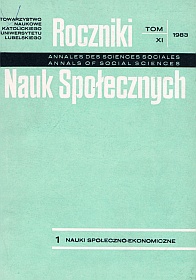Ewolucja gospodarstwa chłopskiego w Republice Federalnej Niemiec
Abstrakt
The present study shows, on the basis of latest sources and monographies, the evolution of family farms in the Federal Republic of Germany in the post-war period, i.e. the causes and the course of the evolution and the prospects of the family agricultural farm. After World War II the process of technization of agriculture, expansion of financial capital to industrial sectors creating means for agricultural production and food industries gave impetus to rapid changes in farms and social microstructures in the country. The creation of the means of agricultural production and manufacturing of agricultural products and their sale have totally been separated from the farmer and farming. The family farm is becoming a specialized producing unit. Live stock farms (milk cow breeding, fattering cattle breeding, pultry breeding — Futterbaubetriebe) are dominant. Commercial farms directed to vegetable production (grain, potatoes, white beans, corn — Marktfruchtbetriebe), approximately 24% of the total number of farms constitute the next category. The three remaining categories are: perennial „culture” farms — Dauerkulturbetriebe: vine, hop, etc., farms for breeding — Veredlungsbetriebe and combined farms. All these farm categories constitute the so-called „agriculture farms”. Another class is formed by vegatable-horticultural farms devided into several categories in a similar way on account of their specialization. The agricultural farm is becoming a mechanized producing unit. The mechanization is of diversified character and it is applied to production operations and procedures, crops, sowing, spreading fertilizer, soil cultivation, transportation, farmyard activities, preparation and delivering of food, etc. The agricultural farm is becoming integrated into the industrial and commercial system.
The processes of specialization, mechanization and integration are accompanied by decreased labour supply, in that a 62% labour decrease among family members and for the hired labour force an 88 per cent and 47,3 per cent decrease for permanent and part-time workers respectively with regard to comparison of 1979 to 1950/51. In 1975 the average employment per 100 ha was 8,9 AK (Arbeitskraft), i.e. labour force items. One AK equals the work of one person aged 16-65 employed throughout a whole year in a agriculture farm exclusively. From the statistical point of view there were 1,2 AK (labour force items) per one farm. The agricultural farm is becoming to a substantial extent a one-company (one- person) producing unit temporally or casually aided by a family member or a hired labourer.
The agrarian structure is undergoing transformation. Only from 1949 to 1979 the number of farms decreased 49 per cent, i.e. from 1.646.800 farms to 815.200 farms in 1979. Farms of smaller area disappear, i.e. farms up 20 ha, as well as those o(f 30 ha in the period of 1980 to 1982, whereas the number and the area of farms over 30 ha are increasing and particularly those over 50 ha. The concentration of land as well as the concentration of live stock in animal breeding farms can be observed.
The population employed in agriculture is to a large extent two-professional. In 1980 there were 49,8% of the farms in F.R.G. in which farm owners earned outside their farms, their main income being drawn from the farm. What characterizes the situation in F.R.G. agriculture is the decrease of the category of the additionally employed, e.g. in 1966 they covered 25,8% of the farms’ total number in that country. Whereas there is an increase in farms’ percentage in which their owners draw income mainly outside their farms (Nebenerwerbsbetriebe), e.g. from 33,4% of the farms total number in 1966 to 39,3% in 1980.
The country population of F.R.G. has undergone the process of feminization and ageing in the post-war period, but they have been cheeked in recent years.
West Germany agriculture is characterized by the big and rapid growth of labour productivity and the overall growth of agricultural production in that country. However, the income drawn by the farmer from his farm is still lower than the wage of worker employed in industry. The income disparity is very sharp in comparison with owners of smaller farms having lowest incomes. Therefore agriculture is subsidired in many ways and in various forms.
There are three conceptions in determining prospects of the family’ run farm in West Germany. The first forecast can be described as a vision of an individual, modern ever — modernizing family farm. The second conception presupposes the evolution of family farms towards larger co-operative farming associations. The third prognosis looks upon the present stage of development of the family farm as its decline. The evolution clearly tends towards concentration of land and constant declining of the so-called smaller farms and their more and more decreasing number with greater and greater agriculture plots based an mechanization and employment of workers who are not farm owners. Agriculture technology implies the development of great commercial agriculture farms. The fourth prognosis is based on the assumption and on the evaluation of the previous evolution as the one which follows a false direction and it forecasts a return to the traditional farm, modernized and with multi-rotation of crops as well as the one of small area and adapted to ecological conditions.
Copyright (c) 1983 Roczniki Nauk Społecznych

Utwór dostępny jest na licencji Creative Commons Uznanie autorstwa – Użycie niekomercyjne – Bez utworów zależnych 4.0 Międzynarodowe.


